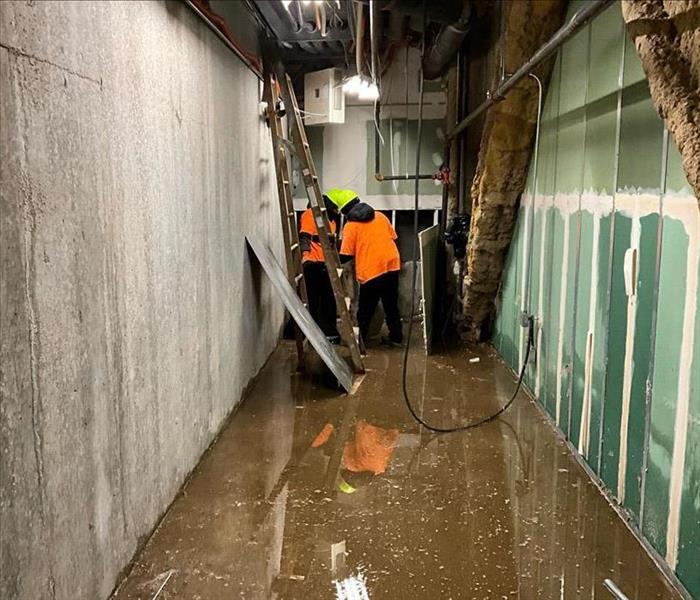Prevent Burst Pipes this Winter: Essential Tips from SERVPRO
1/2/2025 (Permalink)
As temperatures begin to drop in the Kansas City Metro area, the risk of frozen pipes and potential water damage increases. With winter weather just around the corner, it's the perfect time to start preparing your home or business to prevent costly damage caused by burst pipes.
At SERVPRO of Olathe/Lenexa®, we understand how important it is to protect your property, and we’re here to provide you with essential tips to help you avoid frozen pipe disasters this season.
Why Are Frozen Pipes a Concern?
When water freezes inside pipes, it expands, creating pressure that can cause the pipe to burst. This can lead to major water damage, especially if the burst occurs in an area that’s difficult to detect, like in walls or ceilings. As the temperatures drop in Kansas City, especially during those cold snaps, the risk of frozen pipes becomes more significant. A burst pipe can flood your home, damage floors, walls, and personal belongings, and even lead to costly repairs that can be avoided with a little preventative care.
Tips to Prevent Frozen and Burst Pipes
Insulate Your Pipes
One of the best ways to protect your pipes from freezing is by insulating them. Pipes located in unheated areas such as basements, crawl spaces, attics, garages, and exterior walls are particularly vulnerable. Use foam pipe insulation or heat tape to wrap exposed pipes and help keep them warm. This simple step can make a huge difference in preventing pipe bursts.Let Faucets Drip
During extreme cold spells, letting a small stream of water drip from faucets located on exterior walls can relieve pressure from freezing pipes. The moving water is less likely to freeze than water that remains still in the pipes. It also helps maintain the flow of water, preventing it from expanding and bursting the pipes.Seal Cracks and Gaps
Inspect your home for gaps and cracks around windows, doors, and pipes that might allow cold air to enter. Seal any openings with weatherstripping or caulk to keep cold air from reaching your pipes. This is especially important in areas where pipes are exposed, as the cold air can rapidly lower their temperature and cause them to freeze.Open Cabinet Doors
On colder nights, open the cabinet doors under sinks, especially in kitchens and bathrooms, to allow warmer air to circulate around the pipes. This is particularly effective for pipes located on exterior walls, where the risk of freezing is higher.Maintain a Consistent Temperature
Avoid drastic temperature changes in your home. Keep your thermostat set to the same temperature day and night, even if you're leaving town. During particularly cold spells, it’s also a good idea to leave the heat on at a low temperature (around 55°F) if you’re planning to be away for an extended period. A sudden temperature drop inside your home can be enough to freeze vulnerable pipes.Shut Off Outdoor Faucets
Drain and shut off water to outdoor faucets (hose bibs). Disconnect garden hoses and store them inside to prevent water from freezing inside the pipes connected to your exterior faucets. For extra protection, install insulated covers on outdoor faucets to help prevent freezing.Know Where Your Main Water Shutoff Valve Is
In the event of a burst pipe, the faster you can turn off the water, the less damage you’ll experience. Make sure you know where your main water shutoff valve is located and how to operate it. If you’re unsure, take the time to locate it before the cold weather sets in.Consider a Smart Thermostat
If you have a smart thermostat, set it to alert you if the temperature inside your home drops unexpectedly. This can help you take quick action before pipes freeze or burst. Some smart thermostats also allow you to adjust the temperature remotely, which can be helpful if you're away from home during a cold snap.
What to Do if You Suspect Frozen Pipes
Even with preventative measures, there’s always a chance that pipes could freeze. If you suspect you have a frozen pipe, it's important to act quickly:
- Turn off the water supply to your home immediately.
- Apply heat to the frozen area using a hair dryer, space heater, or warm towels. Avoid using open flames, such as a blowtorch, as this can cause a fire hazard.
- Check for leaks or cracks once the pipe has thawed. If you find any, it’s important to contact a plumber right away.
- Contact a water damage restoration professional like SERVPRO of Olathe/Lenexa and the Kansas City Metro if water has leaked into your home. We can help with water extraction, drying, and cleanup to prevent further damage.
SERVPRO Is Here to Help
If the worst happens and your pipes do burst, you can count on SERVPRO to help restore your property. We specialize in water damage restoration and are available 24/7 to assist with cleanup and recovery. Our team is equipped with advanced equipment and techniques to dry your home or business efficiently and thoroughly, minimizing further damage and restoring your property to its preloss condition.
Conclusion
Preventing burst pipes starts with proactive measures and attention to detail. By following these simple tips, you can avoid the hassle, stress, and expense that come with water damage this winter. And if disaster strikes, remember that SERVPRO of Olathe/Lenexa and the Kansas City Metro is always here to help.
Stay safe, stay warm, and don't let the cold catch you off guard. Let us be your partner in protecting your home or business this winter season!






 24/7 Emergency Service
24/7 Emergency Service
